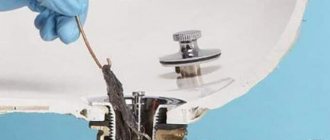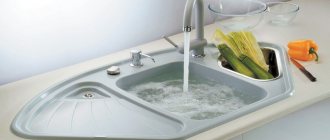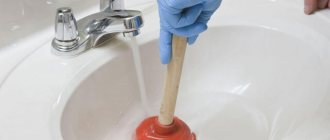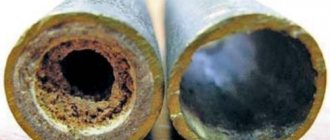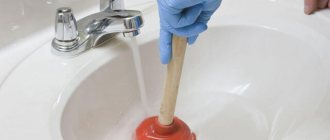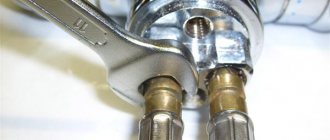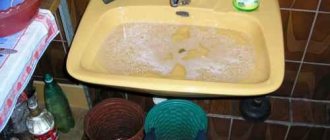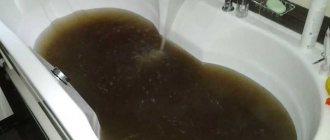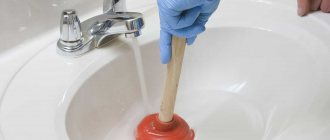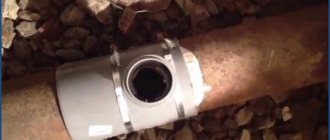One of the common problems that arise in the home is clogged drains in the bathroom and kitchen, which makes it impossible to use plumbing equipment for its intended purpose. Therefore, solving the problem of how to clear a clogged pipe in the kitchen at home is relevant for any owner.
There is a wide range of mechanical devices on the market for dealing with blockages in sewer pipes; to select the best option, it is necessary to have accurate information about the type and materials that caused the blockage. Also, to increase the period of uninterrupted operation of the sewer system, it is useful to know the methods of carrying out preventive work using improvised reagents or household chemicals sold in a specialized retail chain.
Rice. 1 Blockages in the siphon unit
Why do the pipes in the kitchen get clogged?
In everyday life, blockages most often occur in the pipes coming from the kitchen sink; they are caused by the following factors:
- The kitchen sink is mainly used for washing dishes and cooking utensils, so if the pipe is clogged, the first cause of the problem is food residues.
- Kitchen drains also become clogged with grease deposited on the inner pipe casing after washing dishes and food. Dirt and small organic waste stick to it, narrowing the passage channel and slowing down the flow of gray water.
- Incorrect installation of the siphon, a large number of bends or insufficient slope of the drain pipeline, its physical wear and tear can cause frequent blockages.
- Improper operation using predominantly cold water in the sink, lack of preventive cleaning and rinsing are the reasons why the sewer often begins to clog.
Rice. 2 Principle of hydraulic cleaning
Types and methods of pipe cleaning
The main methods of cleaning sewer pipelines can be divided into several groups:
Mechanical. Often the cause of a blockage is a dense plug formed after solid food waste, large debris, and fibers from rags get in and stick together. In this case, the simplest and most effective way to break through a pipe in the kitchen is to use mechanical devices in the form of a steel spiral.
Hydraulic. Popular cleaning methods are the use of moving water masses or fast jets to remove plugs and clean the walls of pipelines from dirt deposits. It is difficult to find an apartment or private house where the household does not use a simple mechanical device for removing blockages called a plunger. For professional cleaning of long-distance sewer pipelines, plumbers use hydrodynamic cleaning technology. Its essence lies in the impact of powerful narrowly directed water jets on the pipe walls and plug, simultaneously pushing the hose forward; during operation, water is supplied to the long pressure hose by an electric water pump. For household sewer cleaning with your own hands, the hydrodynamic method can be used by owners of Karcher car mini washes or similar devices. To clean sinks, you can buy a special long hose for mini sinks with various nozzles in the retail chain, designed to clear pipes from blockages.
Rice. 3 Karcher mini washer and pressure hose with nozzle
Chemical. When choosing how to clean pipes, many people prefer chemical cleaning products, which are widely advertised in the media. According to the manufacturers, their products are capable of dissolving plugs in pipes made from any organic waste, human hair and animal hair, paper fragments, fatty deposits, and limescale. An alternative to factory-made chemicals are folk remedies, the main ones of which are vinegar, salt, baking soda and caustic soda.
Related article:
Sewer cleaning - methods, options, tools and means. A separate article describes in detail how to independently deal with sewerage blockages in a city apartment and private house. Read it, it might be interesting.
How to clean a pipe in the kitchen using improvised means
If pipes become clogged too often, using a plunger or a regular plumbing cable is not an effective way to get rid of them long-term, so many owners are faced with the question of what to do in this case. Finding another solution in the form of purchasing factory-made household chemicals often becomes problematic - the cost of advertised, potent, effective drugs is quite high, and paying a low price for an unknown product can most likely be a waste of money.
Therefore, on Internet resources you can find a considerable number of videos using inexpensive home remedies for cleaning pipes, and the simplest of them is hot water.
Rice. 4 Handy cleaning reagents
Cleaning with boiling water
To make the pipes less likely to become clogged, you should use hot water in the kitchen sink as often as possible; do not forget to use boiling water before cleaning the sewer line from the blockage. Using hot water in case of failure to remove the plug will make further work easier and will dissolve fatty deposits with adhering dirt on the pipe walls.
The disadvantage of using boiling water is that the main material used to make the sewer pipe is polyvinyl chloride (PVC), which has a maximum softening temperature and loss of its shape of about 70 °C. Boiling water is even more dangerous for the thin corrugation of polyvinyl chloride plastic siphons in a sink, bathtub, shower, so for long-term cleaning you should use water with a temperature of no more than 70 ° C, or the clogged pipeline is washed with 100 ° C boiling water for a short period of time up to 5 minutes.
Cleaning the sink with baking soda and salt
Baking soda and salt are usually used for the prevention and cleaning of pipe walls from contaminants; for this, they are dissolved in one liter of hot water in the following ratio: 500 g pack of soda is mixed with 200 g of salt. The hot solution is poured into the sewer system and the drain hole is closed with a stopper for 60 - 120 minutes, after which you can use the sewer. To more effectively remove dirt deposits on the walls, you can additionally use a plunger, moving the flow of dissolved reagents through the pipeline.
Methods for preventing blockages
How to avoid sewer clogging and maintain the functionality of the system for a long time? Follow these guidelines:
By following these recommendations, you can avoid problems with clogged sewer pipes.
The best posts
- What wallpaper goes with white furniture
- Renovation of a bathroom combined with a toilet: photo instructions
- Do-it-yourself reed weaving for beginners with photos and videos
- DIY flower pots. What and how to make a beautiful flowerpot
- Do-it-yourself country toilet in three days from Valery Kazyutin
- Astra: DIY leather flowers
- Curtains for a child's room in a marine style - do-it-yourself design
- What to do and how to open it if the plastic door is jammed
How to clear a clogged pipe in the kitchen using mechanical methods at home
The use of mechanical methods is most effective in situations where the blockage is caused by a dense plug and the application of significant physical force is required to eliminate it. In this case, use plumbing tools or a household plunger, which breaks through the blockage with a reciprocating movement of water flow.
Rice. 7 Types of plungers
Cleaning with a plunger
The retail chain sells a wide range of different plungers, from the simplest models in the form of a rubber hemisphere with a vertical handle, to complex devices that resemble a bicycle pump in their operating principle. When cleaning the sink with a standard plunger, proceed as follows:
- If the water does not drain and the sink is full, place a rubber hemisphere on the drain hole and press the handle 15 - 20 times, making reciprocating movements.
- If the flow is weak, turn on the hot water and fill the sink, after which wait for it to partially drain and fill the siphon and pipeline.
- Place the plunger on the drain hole and press the handle more than 10 times, then check the efficiency of the drain. If necessary, the cleaning procedure is repeated several times.
- To increase the efficiency of working with a plunger, you can use various reagents that help remove dirt and grease from the walls of the pipeline - detergents, washing powders, improvised folk remedies, industrial chemical compounds.
Rice. 8 How to clear a clogged pipe in the kitchen using a plunger at home
Cleaning with a plumbing cable
When deciding how to remove dense plugs that are resistant to chemical solutions and the effects of a plunger, many choose the option of using a plumbing cable, which is a win-win in almost all situations. A large number of different modifications of metal plumbing cables are sold on the market, differing in manufacturing technologies; all varieties can be divided into the following groups:
Rope ropes are reminiscent of a rigging rope, woven from many elastic, rigid wires of small diameter.
Tape - rarely used in domestic conditions, in appearance they resemble a narrow tape with a pass-through nozzle and a movable handle.
Spring cables are a popular option for inexpensive household cables, made in the form of a dense spring made of elastic wire of a relatively large diameter (at least 2 mm). For ease of use, they have a handle at the end and various attachments in the form of brushes, spear-shaped tips, cylindrical cutters, teeth, sliding knives, hooks.
Tension cables are the most durable and rigid cables for professional cleaning, in which the spiral is wound onto a central rigid rope-type core. The number of wound spirals ranges from one to several shells; the cables usually include a handle and removable tips of different shapes.
Rice. 9 Types of plumbing cables
The advantage of plumbing cables lies in the variety of attachments used with them - with their help you can clean the walls of pipelines from dirt and effectively remove blockages. To clean a kitchen drain, proceed as follows:
- Before breaking through the plug, remove the siphon under the sink by unscrewing the plastic union nuts by hand, then wash it in hot water with washing powder or dishwashing detergent.
- Assemble the cable by installing a handle and a nozzle of the desired shape on its tip, and place it near the sewer inlet in the form of rings.
- They insert the spiral into the pipeline, simultaneously making rotational movements, and when in contact with a blockage, increase the rotation speed to increase the force applied to the obstacle - this way the plug is broken through faster.
- As it passes, the spiral is periodically removed from the pipeline and cleaned of dirt by washing it in hot water and detergent. After the plugs are removed, the cable is washed, thoroughly dried and stored for storage, rolled into a ring or wound on a bobbin.
How to clean a sewer pipe in the kitchen with special means
If a pipe in the kitchen is clogged, you can deal with the problem using a variety of chemicals, sold in a wide range of retail chains. Consumers are well aware of such brands for sewer cleaning as Mole, Chirton (Clean Drains), Bagi Pothan, Tiret, Sanfor, Deboucher Aqualon, Selena Anticlog, Sanox “Clean Drain”, Cinderella.
All household chemicals are produced in the form of powders, granules, gels and liquid solutions; their cost varies widely, reaching amounts, for example, from 50 to 500 rubles per 1 liter of liquid preparation.
Cleaning with household chemicals
You can clean sewer pipes with liquid and bulk products; instructions for using each of them are on the packaging; the main difference is the time of the cleaning procedure. Some products are fast-acting and clean the drain within 5 minutes, while other products require one and a half to two hours to complete the work. In addition, some inexpensive domestic compounds (Deboucher Aqualon) differ from imported ones in their high liquid consumption - about 0.5 liters for one cleaning procedure. When cleaning pipes with liquid or gel, proceed as follows:
- Pour the required amount of the drug indicated on the package into the drain hole.
- Wait for the time according to the instructions; for better cleaning, you can deviate from the manufacturer’s instructions and leave the product overnight.
- Upon completion of work, the sewer drain is washed.
Rice. 12 Nets for retaining large waste
Recommendations
When clearing blockages, plumbers advise listening to the following recommendations:
- Any wastewater system requires compliance with preventive measures.
- When working, it is necessary to organize good ventilation. This is necessary for several reasons. First, clogged drains have an unpleasant odor. Secondly, household drain cleaners are not only aggressive in their effects, but also release caustic substances into the air.
- If you are planning a renovation with the installation of plumbing, you need to choose responsible specialists.
- When replacing pipes, plastic ones are preferable to cast iron ones, as they have a smoother surface and are not prone to corrosion.
If you are interested in how to clear a clog in a pipe, sink or toilet, take a look at this section.
What to do if pipes regularly become clogged
If the sewer pipeline often gets clogged, in addition to domestic inconvenience, this leads to unnecessary waste of time and money, so a little prevention of pipe blockages in the kitchen is always useful from any point of view. The arsenal of means used for carrying out preventive work is very wide, ranging from flushing the siphon, installing fine-mesh screens, and ending with the decision to use chemicals or pour detergents into the sewer.
Recommendations for preventing blockages in plastic pipes
To prevent sewer pipes from becoming clogged frequently, the following methods are used:
- The highest chance of a kitchen sink becoming clogged is when large food waste gets into it, so when washing dishes a mesh with small cells is installed over the drain hole.
- Periodically (once a week) wash the drain hole with boiling water, without exceeding the permissible temperature conditions; to increase efficiency, you can use washing powder or dishwashing detergent.
- If the dishes for washing contain an excessive amount of fat, it is dissolved in hot water and the toilet is flushed - this can significantly reduce the amount of fat deposits on the inner lining of the pipes.
- At least once a year, preventive cleaning of the kitchen sewer pipeline is carried out using strong industrial chemicals.
- Before washing dishes, always remove large food residues from them by throwing them into the trash or sewer.
Rice. 13 Prevention of blockages
Elimination of unpleasant odors
Unpleasant odors from household kitchen drains are not a very common occurrence if the sink is properly assembled using a siphon, the water seal of which prevents polluted air from entering the room. Therefore, the only reason for the appearance of foreign odors is a dirty siphon with food residues in the area from the drain to the water seal. To clean it, remove it using the above method, clean it of dirt and wash it in a soapy solution.
Another effective method of dealing with stench from pipes is to purchase products with a variety of scents or those specifically designed to eliminate unpleasant odors.
It is easy to clean a pipe clogged from a kitchen sink with your own hands using various mechanical and chemical methods, the main one of which is the use of a plunger. To eliminate severe blockages with dense plugs, a plumbing cable is used; household chemicals and folk remedies are better suited for preventive cleaning of the walls of the sewer pipeline.
Mechanical cleaning
To implement this method, you will, at a minimum, need a plunger. Everyone knows how to use a plunger, but if the blockage cannot be cleared using chemicals and a plunger, you will have to take a special brush or at least a wire with a curved end.
If you have any of these items, prepare for battle. First of all, you need to prepare the place by clearing and removing any objects that are in your way - you're in for a pretty messy job. Then you need to get directly to the sewer pipe itself, i.e. remove the siphon from the sink when you see an open hole.
Mechanical cleaning of clogs
Now that you are ready, put on your gloves, pick up a pipe cleaner and insert it into the pipe. Then you need to carefully move your tool along the pipe, constantly turning it. If the wire or pipe cleaner hits something, don’t hesitate to apply more force, just make sure it’s not turning the pipe. Thus, by pushing the blockage, you gradually destroy it, and subsequently it will go away on its own in the right direction.
If the pipe is clogged close to the entrance, it would be wiser to use a spiral (it can also be made from wire). Everything is much simpler here, just scroll the spiral clockwise, and when it goes deep enough into the plug that is preventing the outflow of water, it can be pulled out.
In general, this method quite effectively removes blockages in a plastic sewer pipe, but its main disadvantage is that it cannot be used in a winding sewer system (with many turns and elbows).
